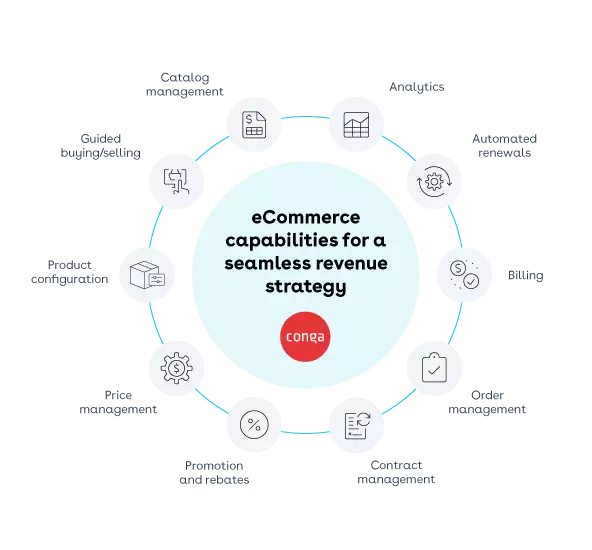
10 essential eCommerce capabilities for a seamless revenue strategy

Advancements in eCommerce capabilities have revolutionized selling strategies by creating a comprehensive platform for buying or selling goods and services through multiple digital channels. For B2B businesses, an effective eCommerce strategy is crucial for optimizing revenue and meeting new customer demands.
When planning digital commerce initiatives, it's essential to explore 10 key eCommerce capabilities. These capabilities will enable you to operate efficiently, provide a top-tier customer experience, and achieve a seamless revenue strategy.

1. Catalog management
eCommerce capabilities rely heavily on catalog management. This system handles intricate product data, hierarchies, and various types of content, such as marketing, technical, and sales documents, across single or multiple catalogs. A robust catalog management system ensures consistency of product data across all channels, improving the user experience and minimizing errors. Introducing new product offerings also becomes simpler and quicker when there is a single source of truth instead of needing to update different systems for different channels.
2. Guided buying/selling
Guided buying and selling processes aim to lead users to products and services that match their needs using their customer data. Typically, questionnaires with branching logic guide customers and partners through product choices. Recommendation engines then display product substitutions, upgrades, options, and different product bundles. In B2B eCommerce, guided buying and selling is essential as it provides guardrails that help simplify the purchase process for complex products. This enables buyers to make informed decisions while also improving overall sales efficiency.
3. Product configuration
Configurators oversee the relationships, rules, and limitations that guide individual components, products, and service combinations. They allow sales teams, partners, and customers to customize solutions to address their unique requirements. The administrative tools for managing these configurators should enable business users to create, test, and implement various models easily. Product configurators help prevent expensive errors during the configuration process.
4. Price management
Pricing engines automate processes for setting, administering, and executing prices. This automation greatly improves efforts to develop, maintain, analyze, and update critical documentation like price lists, policies, and discounts—regardless of channel, region, or corporate division. Having an effective way to manage prices makes it much easier to implement innovative pricing models like attribute-based pricing, subscription-based pricing, and value-based pricing.
5. Promotions and rebates
A systematic approach to managing incentives is extremely valuable for marketing campaigns and channel strategies. The system should automate tasks for defining, launching, and ending promotions and rebates. It's important to track actual sales and orders to assess the program's effectiveness, and the payment processes must be accurate and completely auditable.
6. Contract management
Contract lifecycle management (CLM) oversees contracts from creation through execution, renewal, and expiration. Within an eCommerce strategy, CLM provides significant benefits by streamlining contract processes, reducing errors, and ensuring compliance with legal and regulatory standards. It facilitates efficient contract authoring, negotiation, and approval workflows while also offering visibility into contract terms and performance. By automating these tasks, CLM reduces the time it takes to close deals, mitigates risks, and supports recurring revenue stream growth.
7. Ordering management
This functionality connects the buying experience with order fulfillment. The process of creating orders needs to be fast, seamless, and error-free. All details for order fulfillment need to be accurately recorded and communicated to the appropriate production or logistics departments. In B2B commerce, relevant quoting and proposal information should automatically transfer to orders and contracts to avoid redundant data entry and errors, with all details validated and transmitted to bills of materials (BoMs) and billing systems.
8. Billing
Billing solutions receive information from order capture and orchestration solutions across channels so that you can invoice for full, partial, or pending orders. Also, billing solutions can synchronize with ERP and accounting systems to enable auditing, streamline financial reporting, and improve compliance.
9. Automated renewals
The ability to automatically and efficiently handle subscription renewals is essential for business models that rely on recurring revenue. Alerts and notifications give advance notice of expirations, while asset-based ordering provides visibility into past purchases. Recommendations based on pricing updates, new product introductions, end-of-term schedules, and contract pricing can support upselling, swaps, and cross-selling strategies.
10. Analytics
It is a significant advantage to understand real-time trends in buying patterns, such as product demand, realized prices, and discounting activities. Predictive and prescriptive analytics help enterprises identify, assess, and act on key indicators like sales cycle times, conversion rates, win rates, deal slippage, average transaction values, and renewals. Drill-down features permit revenue teams to examine issues more closely by region, company, channel, product, customer segment, and other dimensions.
eCommerce capabilities for a seamless revenue strategy
When assessing eCommerce solutions, it is important to examine these 10key digital commerce processes, as they are essential for developing an effective revenue strategy. Each process plays a critical role in overseeing various aspects of the revenue lifecycle, from initial customer engagement to ongoing revenue management.
Effective Revenue Lifecycle Management optimizes every stage of the customer journey, ultimately leading to sustained business success in the competitive digital marketplace. By aligning your eCommerce needs with these processes, you can improve operational efficiency, enhance customer satisfaction, and drive growth.



